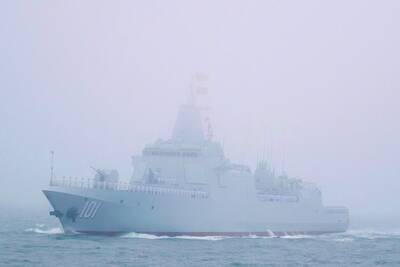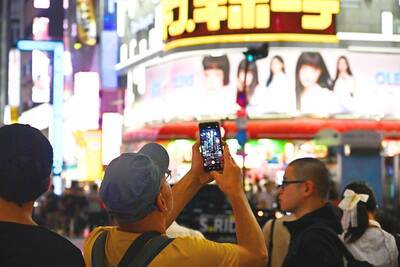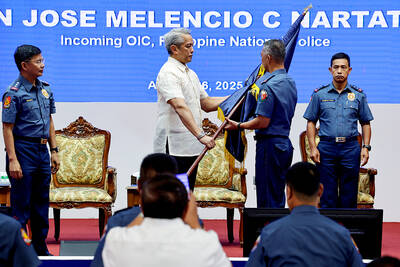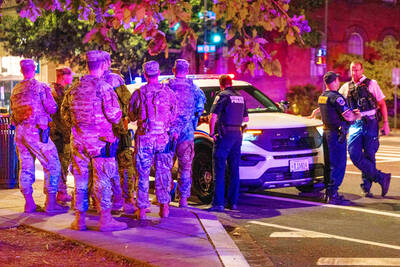British academics have used geographic profiling in a study that backs up a theory about the identity of mysterious street artist Banksy, the authors said on Friday.
Scientists at Queen Mary University of London said in a study published in the Journal of Spatial Science that the pattern of how Banksy’s artworks were distributed suggested he is artist Robin Gunningham.
Gunningham was first named as Banksy by the Daily Mail newspaper in 2008.

Photo: AP
Banksy’s often politically themed street art has made him a celebrity in Britain, despite his true identity never having been confirmed.
His most high-profile recent project was painted in the southwest England town of Weston-super-Mare in Somerset and called Dismaland, which last year mocked the conventions of amusement parks.
Geographic profiling is a technique used in fields from criminology to studying patterns of infectious disease.
The study analyzed a series of locations of Banksy’s artworks in London and Bristol and mapped them against “anchor points,” such as the homes of people suspected of being Banksy, to draw conclusions about possible identity.
“Our analysis highlights areas associated with one prominent candidate, supporting his identification as Banksy,” the study said.
“More broadly, these results support previous suggestions that analysis of minor terrorism-related acts [eg graffiti] could be used to help locate terrorist bases before more serious incidents occur, and provides a fascinating example of the application of the model to a complex, real-world problem,” it added.
One of the research team, Steve Le Comber, told the BBC: “I’d be surprised if it’s not [Gunningham], even without our analysis, but it’s interesting that the analysis offers additional support for it.”
The BBC also reported that Banksy’s legal team had contacted staff at the university with concerns about how the research was to be promoted.

BRUSHED OFF: An ambassador to Australia previously said that Beijing does not see a reason to apologize for its naval exercises and military maneuvers in international areas China set off alarm bells in New Zealand when it dispatched powerful warships on unprecedented missions in the South Pacific without explanation, military documents showed. Beijing has spent years expanding its reach in the southern Pacific Ocean, courting island nations with new hospitals, freshly paved roads and generous offers of climate aid. However, these diplomatic efforts have increasingly been accompanied by more overt displays of military power. Three Chinese warships sailed the Tasman Sea between Australia and New Zealand in February, the first time such a task group had been sighted in those waters. “We have never seen vessels with this capability

A Japanese city would urge all smartphone users to limit screen time to two hours a day outside work or school under a proposed ordinance that includes no penalties. The limit — which would be recommended for all residents in Toyoake City — would not be binding and there would be no penalties incurred for higher usage, the draft ordinance showed. The proposal aims “to prevent excessive use of devices causing physical and mental health issues... including sleep problems,” Mayor Masafumi Koki said yesterday. The draft urges elementary-school students to avoid smartphones after 9pm, and junior-high students and older are advised not

Philippine President Ferdinand Marcos Jr has fired his national police chief, who gained attention for leading the separate arrests of former Philippine president Rodrigo Duterte on orders of the International Criminal Court and televangelist Apollo Carreon Quiboloy, who is on the FBI’s most-wanted list for alleged child sex trafficking. Philippine Executive Secretary Lucas Bersamin did not cite a reason for the removal of General Nicolas Torre as head of the 232,000-member national police force, a position he was appointed to by Marcos in May and which he would have held until 2027. He was replaced by another senior police general, Jose

POWER CONFLICT: The US president threatened to deploy National Guards in Baltimore. US media reports said he is also planning to station troops in Chicago US President Donald Trump on Sunday threatened to deploy National Guard troops to yet another Democratic stronghold, the Maryland city of Baltimore, as he seeks to expand his crackdown on crime and immigration. The Republican’s latest online rant about an “out of control, crime-ridden” city comes as Democratic state leaders — including Maryland Governor Wes Moore — line up to berate Trump on a high-profile political stage. Trump this month deployed the National Guard to the streets of Washington, in a widely criticized show of force the president said amounts to a federal takeover of US capital policing. The Guard began carrying